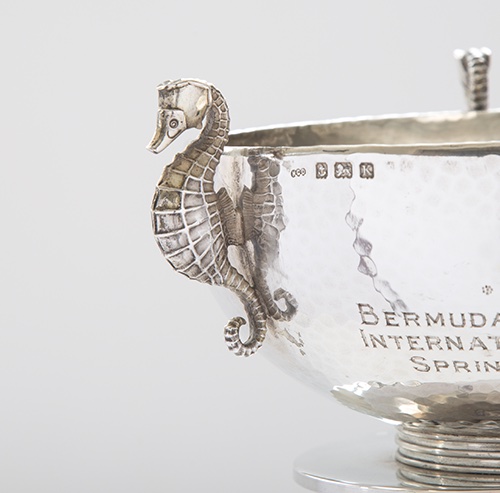Mystic Seaport Museum’s ‘Sea as Muse’ Exhibit Features 115 Unique Objects
Mystic, Conn., SEPT. 23, 2021 – Dolphins and mermaids. Seaweed and sea urchins. Fast ships and ocean waves. Mystic Seaport Museum visitors to the Sea as Muse exhibit will find delightful details like these, inspired by sea life and life on the sea.
The Sea as Muse exhibit, funded by a generous grant from the Henry Luce foundation, opened in September and will run until summer 2022. On display are 115 remarkable objects, made by silversmiths and wood carvers that were inspired by the sea.
The exhibit showcases more than 50 silver trophies, many locally made in Meriden, CT or Providence, RI. Both places were home to some of the largest silver manufacturing companies in the country in the 1800s.
“In the late 19th Century, silversmiths and wood carvers often drew inspiration from the sea, and we are lucky to be able to showcase more than 100 of these pieces,” said Peter Armstrong, the Museum President.
Many of the trophies were awards for yachting and sailing competitions and while previous exhibits focused on the yacht themselves and their often-famous owners, this exhibit offers a fresh perspective, focusing on the fine art and intricate design of the treasures themselves. The incredible detail on the trophies depicts dolphins, sea horses, mermaids, anchors, as well as seashells sculpted by hand.
One of the elegant trophies has a unique background in that it was a very expensive insult! In big regattas during the late 1800s, it was common to give the owners of losing yachts a presentation piece as recognition of their participation. However, the Livonia trophy was awarded by anonymous Americans in London who clearly intended to mock the Livonia’s owner.
It commemorates the results of a yachting challenge to the New York Yacht Club by James Ashbury of England, who was determined to win the America’s Cup for the Royal Harwich Yacht Club. In a series of 5 races in October 1871, Ashbury’s Livonia competed against 2 American yachts, winning just 1 race against the Columbia. Ashbury contested the result but after an investigation, the New York Yacht Club affirmed its original decision. This trophy was not awarded by the New York Yacht Club however, as the engraving tells us that it was commissioned and presented to Ashbury by “Americans in London” as acknowledgment of Ashbury’s single win. The fact that it only mentions 1 win out of 5 and that both Ashbury’s name and the name of his yacht were misspelled all point towards this trophy being one very expensive insult. The figures on top of the cup further suggest this, as the standing figure is Columbia, representing the United States, and the figure that kneels before her is Britannia, representing Great Britain. These two figures were depicted frequently in art and political cartoons that aimed to show that both nations were equally great, however on this trophy, Britannia shows subservience to Columbia—a subtle but clear suggestion of Britain’s—and Ashbury’s—inferiority.
Unsurprisingly, Ashbury refused the cup and it was returned to the unknown Americans who gave it to him.
One piece called “the Palladium Trophy,” was named after The Daily Palladium, a newspaper in New Haven. It was made in 1887 in Meriden, CT and donated by the publication. It sometimes is referred to as the “Neptune Trophy.”
The exhibit includes masterpieces from The Gorham Manufacturing Company and Tiffany, including three Astor Cups, named for John Jacob Astor IV, who donated a large sum of money to the New York Yacht Club to pay for two trophies a year that would bear his name.
While much of the exhibit showcases fine silver, there is an incredible wood carving portion, featuring items from the yacht Aloha II, which was owned by a wealthy American named Arthur Curtiss James. The carvings on display are from the yacht’s deck saloon and include a series of magnificently carved wood panels that illustrate excerpts from an ancient Norse epic poem.
###
ABOUT MYSTIC SEAPORT MUSEUM:
Mystic Seaport Museum is the nation’s leading maritime museum. Founded in 1929 to gather and preserve the rapidly disappearing artifacts of America’s seafaring past, the Museum has grown to become a national center for research and education with the mission to “inspire an enduring connection to the American maritime experience.”
The Mystic Seaport Museum grounds cover 19 acres on the Mystic River in Mystic, CT, and includes a recreated New England coastal village, a working shipyard, formal exhibit halls, and state-of-the-art artifact storage facilities. The Museum is home to more than 500 historic watercraft, including four National Historic Landmark vessels, most notably the 1841 whaleship Charles W. Morgan, America’s oldest commercial ship still in existence. At Mystic Seaport Museum, we strive to create an environment where visitors not only learn from us, but we learn from them. The concept is called Public History and it allows our visitors to experience history in ways they haven’t before.



